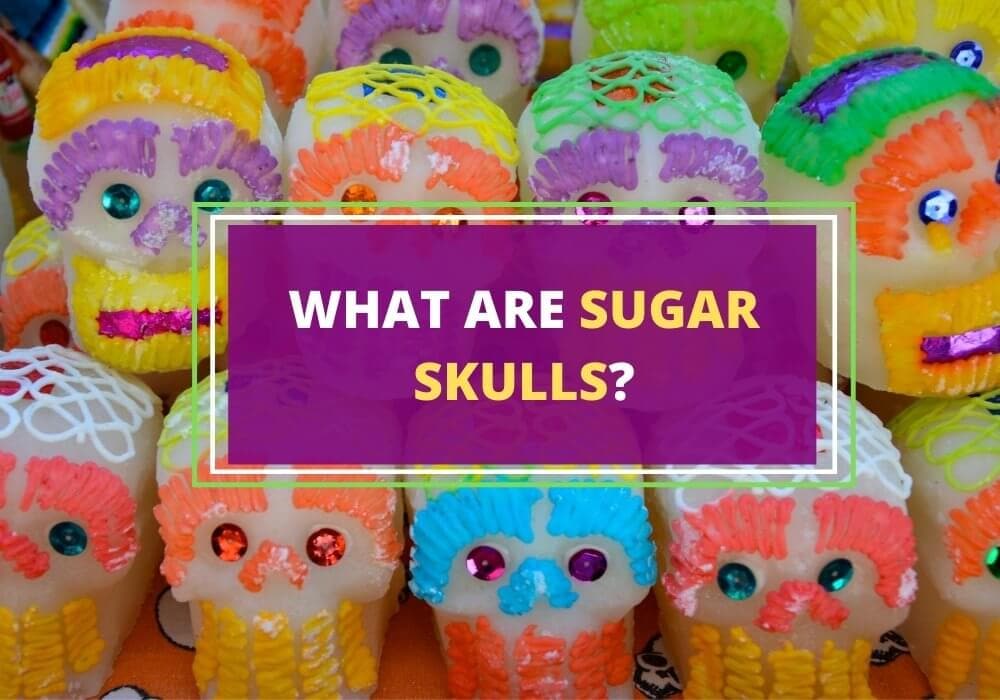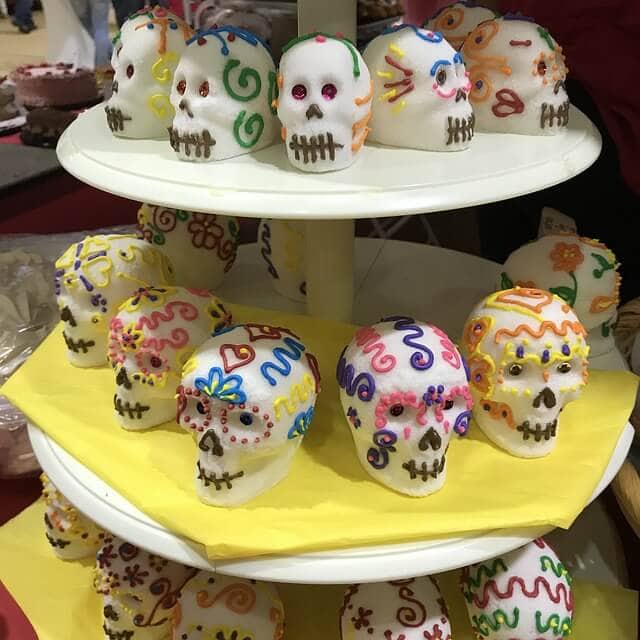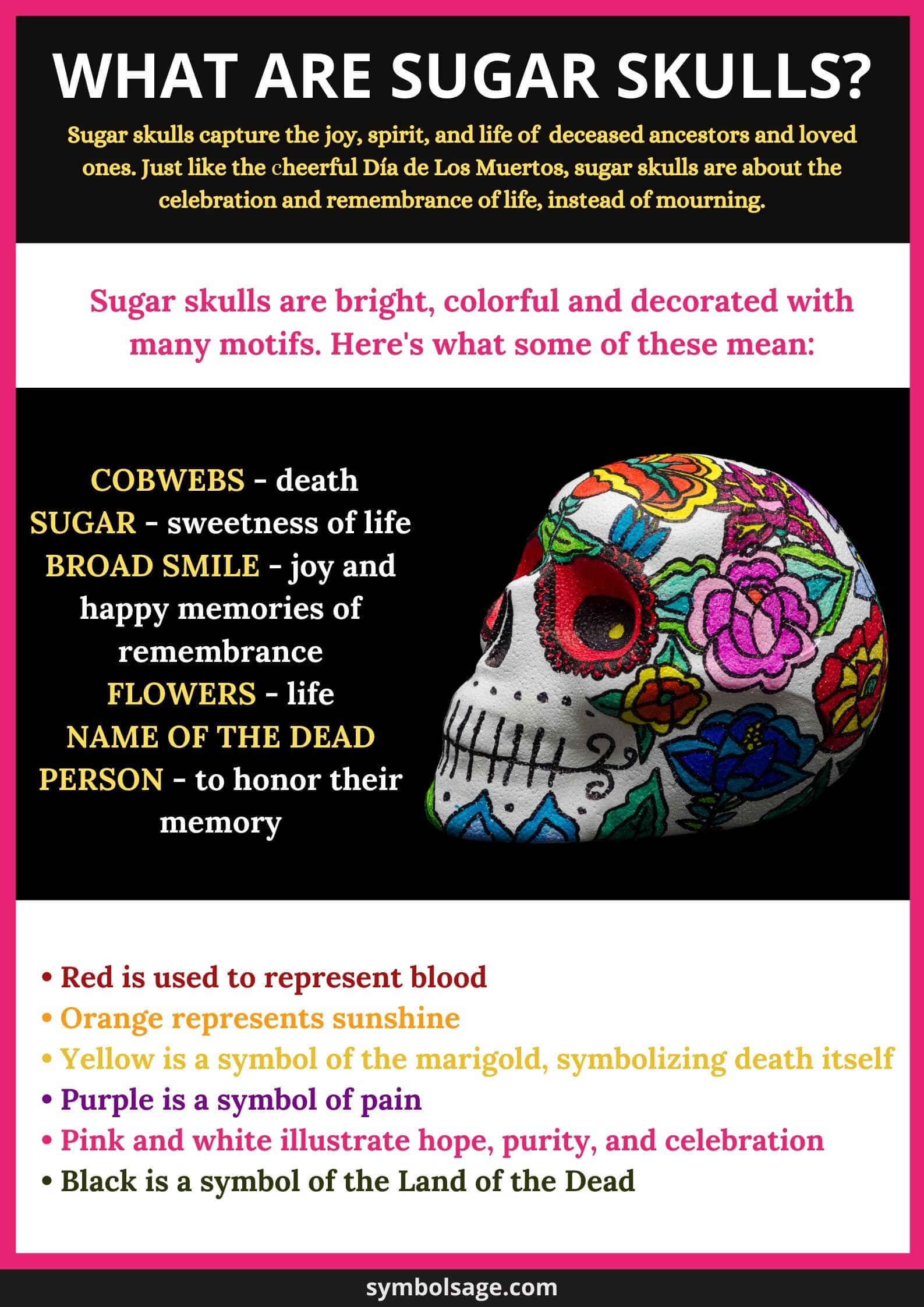
Table of Contents
Sugar skulls, or Calaveras de azúcar, are deeply rooted in the Mexican tradition and culture. This festive and whimsical symbol is an important part of the Day of the Dead, or Día de Los Muertos – a Mexican holiday that marks the remembrance and celebration of those who have passed. The skulls are made of sugar and embellished with bright colors to represent death with sweetness and nostalgia. Sugar skulls challenge the idea that death is frightening, macabre and to be avoided. Let’s take a closer look at the sugar skull.
The Sugar Skull and The Day of The Dead
Día de Los Muertos is a Mexican holiday that takes place from midnight on October 31st to November 2nd. It coincides with a Catholic holiday All Souls’ and All Saints’ Day in western countries.
It’s a celebration of life and a chance to honor the dead at the same time. Sugar skulls represent death, but in the Mexican culture, death is about celebration, not sorrow.
On Día de Los Muertos, it’s customary to leave sugar skulls on the altars as an offering, or ofrenda, to the souls people want to remember. Sometimes, the skulls are gifted to loved ones that are still living, as a sign of appreciation and thoughtfulness.
When Did Día de Los Muertos Begin?
The holiday has its roots in Aztec rituals, before the Spanish invasion, where people used to put real skulls on the altars for the dead. However, when Spaniards saw these rituals, they found it was grotesque to have real bones on the altars as offerings. Therefore, they exchanged these with the ones made from sugar paste and, sometimes, clay.

Sugar was easily accessible at that time, even to those with little money, so it was a natural choice. Once Mexicans learned they could make these skulls with just water and sugar, the idea of the sugar skull evolved and became an important symbol of the day.
During the Day of the Dead, these decorative skulls adorn every household and tomb in Mexico. It’s a part of their tradition to have them homemade and placed on family altars, to honor the person who had passed away.
Sometimes they put them on tombstones along with the favorite foods and items of the deceased one. They would write the name of the deceased on the skull’s forehead. Depending on the age of those who passed, the skulls varied in size. The larger skulls are dedicated to adults, and the baby skulls are for those who passed at a young age.
The skulls differ in color as well. Some are covered in icing and ribbons, and others are decorated with glitter and other bright ornaments like bows and hats.
The reason this holiday, that revolves around death, is so colorful and bright instead of gloomy and sad, is because it’s a celebration of the lives led by those who are now gone. It’s not about mourning and dwelling on the loss of a loved one, but about remembering their lives and the impact they left behind. Just because they are not among the living doesn’t mean they are entirely gone; their spirit will keep on living in the hearts and memories of their families.
Symbolism of the Sugar Skull
While most representations of skulls are either morbid or creepy, sugar skulls are different. In contrast to many other cultures, sugar skulls are often presented as cheerful and happy. They capturethe joy, spirit, and life of the deceased ancestors and loved ones.
A great part of its symbolic meaning lies in the name itself. While skulls and skeletons may conjure an image of fear of death, the word sugar counteracts that. Its name implies that there is a certain sweetness in death. Death doesn’t have to be scary and bitter; it can also be sweet. Just like the cheerful Día de Los Muertos, sugar skulls are about the celebration of life and remembering, instead of mourning.
Sugar skull come in different shapes, colors, and interpretations. Still, there are a few elements that are traditional in Mexican culture, with specific symbolic meanings:
Various Motifs and Colors
Different shapes of the skulls tell different stories. A smaller skull is in honor of an infant or a child who passed. A larger skull is a symbol of ancestors and elders.
Similarly, the family of the deceased might decorate the skull in a way to resemble those who passed. They would also often draw a broad smile. The smile is meant to show joy and happy memories you think of when you remember a lost loved one. It also shows that the things we fear the most aren’t as scary as we think.
The skulls are usually embellished with both flowers and cobwebs. Flowers symbolize life, while cobwebs represent death.
Sugar skulls can be decorated with various colors, and each of them holds a special meaning:
- Red is used to represent blood
- Orange representssunshine
- Yellow is a symbol of the Mexican or Aztec marigold, representing death itself
- Purple is a symbol of pain
- Pink and white illustrate hope, purity, and celebration
- And finally, black is a symbol of the Land of the Dead
Different Eye-Shapes
It’s not uncommon to find sugar skulls with different shapes for their eyes. Let’s break down what these shapes are and what are their meanings:
- Hearts as eyes is a way to add a feminine element to the skull, which also symbolize the love for the person who passed.
- Candles as eyes are a symbol of remembrance of the passed loved one. Lighting a candle for someone also represents a spiritual way of honoring them and guiding their soul towards the light.
- Marigolds are beautiful tall flowers used to represent the fragility of life. It’s believed that their vibrant color and pungent smell guide the spirits of the loved ones to their families’ altars.
- Diamond eyes is a less traditional motif found on sugar skulls. This sparkling, rare, and durable gem symbolizes theinner beauty of an individual and the value it gives them.
Names Written on the Skulls
Sugar skulls often have names written on their foreheads. It’s thought that when you place a sugar skull with the name of the person who passed on the altar, you honor the memory of that person. It goes along with other offerings, such as pictures of the deceased, and their favorite drinks and dishes.
The part of the custom around the Day of the Dead is to give a sugar skull to a living friend or family member with their names on it. In the Mexican culture, this act isn’t seen as offending since death is the only certain thing in this life. Instead, it’s regarded as a kind act that shows how that person is meaningful to you. It represents reserving a spot in the underworld, one that person passes and crosses tothe life after death.

Sugar Skull in Fashion
Mexicans value the meaning of the sugar skull, to the point where the concept is taken far beyond the Día de Los Muertos.
In fact, shirts and other clothing pieces with the sugar skull design are very popular not only in Mexico but worldwide. Besides clothing, you can find sugar skull symbols in candies, and depicted on various accessories like watches and phone cases. Many people get creative and put on sugar skull make up for Halloween.
With movies like Disney’s Coco celebrating the Día de Los Muertos, the popularity of the festivities and by extension symbols like the sugar skull are increasing globally.
Sugar Skull Tattoos
Some people have them tattooed in memory of the loved ones lost. There are unlimited ways artists express their creativity with this amazing design. The most popular are floral sugar skull tattoos, black and white versions, as well as realistic variations.
You can also find Frida Kahlo sugar skull tattoos, depicting both the most celebrated Mexican artist and the glorious Día de Los Muertos symbol.
Sugar Skull Jewelry
Besides tattoos, this extraordinary design is a popular motif found in jewelry such as pendants, necklaces, earrings, and bracelets. These often feature the festive skull made of silver or stainless steel, decorated with many colors and different shapes. It’s not uncommon to find a piece that has crystals for eyes or depicting an animal.
If you want to pay tribute to the holiday, honor the memory of the loved one who passed, or simply have a great piece that compliments your style, the well-known Calavera would be an excellent choice.
To Wrap It Up
By recognizing the profound meaning of the sugar skull symbol, it’s clear that the tradition goes far beyond just decorating a skull made of sugar. There are numerous representations of the amazingly beautiful Calavera that pays tribute to the deceased. It’s a symbol of everlasting importance, that’s lasted from the Spanish conquest of the Aztec Empire to modern days.








